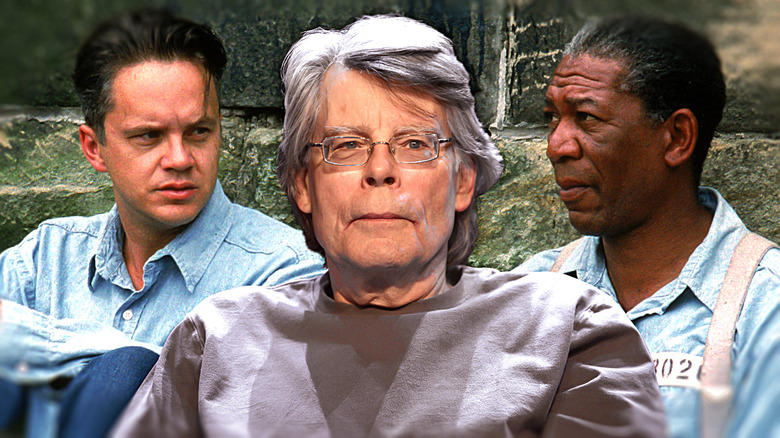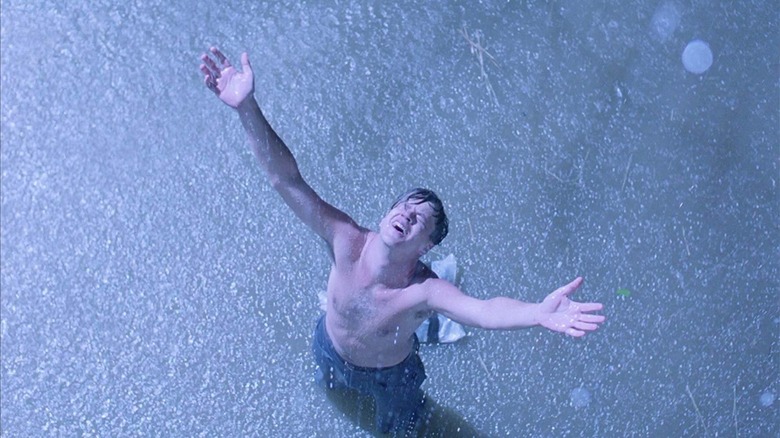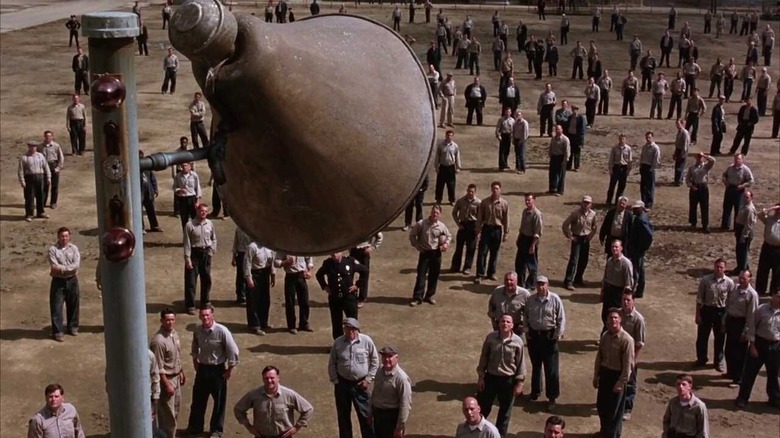The Shawshank Redemption Was A Box Office Disappointment, And Stephen King Knows Why
It's probably fair to say "The Shawshank Redemption" is a modern classic. The prison drama became a home video and TV staple, watched and re-watched over and over again. Based on a novella by Stephen King, it's one of the best King movies — a fact that King himself even agrees with. "When I first saw it, I realized [the director] made not just one of the best movies ever done from my work, but a potential movie classic," the author once said. Directed by Frank Darabont, who also helmed the King adaptations "The Green Mile" and "The Mist," "The Shawshank Redemption" tells the story of Andy Dufresne, played by Tim Robbins. In 1947, Andy is convicted of murdering his wife and her lover — a crime he didn't actually commit, despite evidence to the contrary. Andy is sentenced to life in prison, and he's sent to Shawshank State Prison in Maine.
As you might imagine, life in prison is hard and brutal — Andy is targeted by other inmates for frequent attacks. But he also finds a way to adapt. He befriends Red, played by Morgan Freeman. The narrator of the tale (it's safe to say this is the movie that made everyone realize Freeman has a killer voice for narration), Red is a convict who is skilled at smuggling in contraband, and he and Andy grow close as the years tick on. Andy begins to improve life in the prison not just for himself, but for others — including the guards (he was a banker before sentenced to prison, and helps the guards do their taxes). Over time, Red gets Andy a few things from the outside. Andy says he wants a rock hammer to shape some rocks into chess pieces. He also requests a poster of actress Rita Hayworth for the wall of his cell.
Despite some positive changes, prison is still prison, and Andy dreams of being released. He thinks he might finally have a way out when a new inmate named Tommy arrives and tells everyone he has proof of Andy's innocence, due to the fact that he once shared a cell with the actual killer of Andy's wife and her lover. However, the prison's corrupt warden, who has been using Andy to launder prison funds, worries Andy will rat him out, so he has Tommy killed. Things look hopeless for Andy. And then, one morning, the guards find Andy's cell completely empty. They eventually discover a hole in the wall behind the poster he's hung up — it turns out Andy has spent decades tunneling through the wall using the rock hammer. A year later, Red is finally released on parole. He eventually heads to Zihuatanejo, Mexico, where he and Andy reunite.
The Shawshank Redemption was a box office flop ... at first
"The Shawshank Redemption" is a stirring, emotional saga, a great story of male friendship, and a cracking good film. Darabont's screenplay adaptation of King's story isn't afraid to take its time, and you really get the sense of years passing as Andy remains locked up for a crime he didn't commit. Both Robbins and Freeman are excellent in their respective roles, Roger Deakins' cinematography manages to make the drab interior of the prison gorgeous in its own unique way, and Thomas Newman's lush score is an all-timer. With all this in mind, it's easy to understand why "The Shawshank Redemption" became so beloved by viewers.
But it didn't start out that way. After playing at the Toronto International Film Festival, "The Shawshank Redemption" hit theaters on September 23, 1994 ... and promptly flopped. Audiences did not turn out for the film, and its initial box office run earned the film only $16 million against a $25 million budget. Things would eventually change, though. For one thing, "Shawshank" ended up garnering seven Academy Award nominations. This inspired a re-release of the film, and this re-release was far more successful. Eventually, when the movie found its way onto VHS, it became the top video rental of 1995.
But why did the film initially fail? Perhaps people weren't particularly inspired to see a movie set in the prison. Perhaps it was the fact that "Shawshank" also opened the same year as films like "Pulp Fiction" and "Forrest Gump," both of which drew bigger audiences. But if you ask Stephen King, the reason the film flopped is simple: it's because of the title.
The Shawshank Redemption eventually found its audience
The book "Stephen King Goes to the Movies" collects a handful of Stephen King stories that have been turned into films, and King provides a brief introduction to each tale. For the introduction to "Shawshank," which is titled "Rita Hayworth and the Shawshank Redemption" in story form, King admits that he never really liked the title of his short story, and felt like the movie title wasn't much better. He also says that this is probably why the movie didn't perform well when it first hit theaters. "It was not — at first — much of a success at the box office," King writes. "Part of the reason may have been the title, which conveyed no information and called up no image in the potential moviegoer's mind. Unfortunately, nobody could think of a better one, and that included me. I never liked the title of my own story, and don't to this day."
King has a point. While "The Shawshank Redemption" title makes sense to us now that the film has been part of our pop culture consciousness for 30 years, it was kind of meaningless to audiences in 1994. Shawshank isn't a real place, so if you weren't familiar with King's story, you likely had no idea what the heck it meant. Thankfully, "The Shawshank Redemption" eventually found its audience, and while I think there was a bit of backlash to the film after it re-ran on TV so many damn times, I firmly believe it's an excellent movie that still holds up to this day. As King says in "Stephen King Goes to the Movies," "This is as good as films get on the subject of how men love each other, and how they survive."


